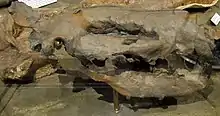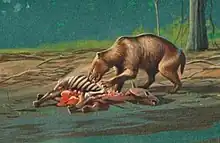Hemipsalodon
Hemipsalodon ("half-scissor tooth") is an extinct genus of hyainailourid hyaenodonts from the paraphyletic subfamily Hyainailourinae that lived in North America during the middle to late Eocene.[4][5]
| Hemipsalodon Temporal range: Middle to Late Eocene | |
|---|---|
 | |
| Skull of Hemipsalodon grandis | |
 | |
| Restoration of H. grandis | |
| Scientific classification | |
| Domain: | Eukaryota |
| Kingdom: | Animalia |
| Phylum: | Chordata |
| Class: | Mammalia |
| Order: | †Hyaenodonta |
| Superfamily: | †Hyainailouroidea |
| Family: | †Hyainailouridae |
| Subfamily: | †Hyainailourinae |
| Genus: | †Hemipsalodon Cope, 1885 |
| Type species | |
| †Hemipsalodon grandis Cope, 1885 | |
| Species | |
| Synonyms | |
|
synonyms of species:
| |
Description
The skull of Hemipsalodon grandis is 45 centimetres (18 in) in length, with a lower jaw length of 34 centimetres (13 in). The most complete skull (O.M.S.I. No. 619), belonged to an old individual. It is powerfully-built, and overall superficially resembles the mesonychid Harpagolestes. The nasal opening is quite large. The canines are greatly enlarged. The anterior portion of the skull is broad anteriorly, but narrows down considerably posteriorly.[6]
Phylogeny
The phylogenetic relationships of genus Hemipsalodon are shown in the following cladogram.[7][8][9][10][11]
| †Hyaenodonta |
|
||||||||||||||||||||||||||||||||||||||||||||||||||||||||||||||||||||||||||||||||||||||||||||||||||||||||||||||||||||||||||||||||||||||||||||||||||||||||||||||||||||||||||||||||||||||||||||||||||||||||||||||||||||||||||||||||||||||||||||||||||||||||||||||||||||
See also
References
- E. D. Cope (1885.) "The White River beds of Swift Current River, Northwest Territory." American Naturalist 19(2):163
- E. P. Gustafson (1986.) "Carnivorous mammals of the Late Eocene and Early Oligocene of Trans-Pecos Texas." Texas Memorial Museum Bulletin 33:1-66
- Schlaikjer, Erich M. (1935). "Contributions to the stratigraphy and paleontology of the Goshen Hole area, Wyoming. III. A new basal Oligocene formation". Bulletin of the Museum of Comparative Zoology. 76 (3): 71–93.
- McKenna, Malcolm C.; Bell, Susan K. (1997). Classification of Mammals Above the Species Level. New York: Columbia University Press. ISBN 978-0-231-11012-9. Retrieved 16 March 2015.
- G. F. Gunnell (1998.) "Creodonta". In C. M. Janis, K. M. Scott, and L. L. Jacobs (eds.), "Evolution of Tertiary Mammals of North America, Volume 1: Terrestrial Carnivores, Ungulates, and Ungulate like Mammals", Cambridge University Press, 703 pages Hemipsalodon
- Mellett, James Silvan (1969). "A skull of Hemipsalodon (Mammalia, Deltatheridia) from the Clarno Formation of Oregon". American Museum Novitates (2387). hdl:2246/2597.
- Borths, Matthew R.; Stevens, Nancy J. (2017). "Deciduous dentition and dental eruption of Hyainailouroidea (Hyaenodonta, "Creodonta," Placentalia, Mammalia)". Palaeontologia Electronica. 20 (3): 55A. doi:10.26879/776.
- Matthew R. Borths; Nancy J. Stevens (2019). "Simbakubwa kutokaafrika, gen. et sp. nov. (Hyainailourinae, Hyaenodonta, 'Creodonta,' Mammalia), a gigantic carnivore from the earliest Miocene of Kenya". Journal of Vertebrate Paleontology. 39 (1): e1570222. Bibcode:2019JVPal..39E0222B. doi:10.1080/02724634.2019.1570222. S2CID 145972918.
- Floréal Solé; Bernard Marandat; Fabrice Lihoreau (2020). "The hyaenodonts (Mammalia) from the French locality of Aumelas (Hérault), with possible new representatives from the late Ypresian". Geodiversitas. 42 (13): 185–214. doi:10.5252/geodiversitas2020v42a13.
- Solé, F.; Morlo, M.; Schaal, T.; Lehmann, T. (2021). "New hyaenodonts (Mammalia) from the late Ypresian locality of Prémontré (France) support a radiation of the hyaenodonts in Europe already at the end of the early Eocene". Geobios. 66–67: 119–141. Bibcode:2021Geobi..66..119S. doi:10.1016/j.geobios.2021.02.004. S2CID 234848856.
- Averianov, Alexander; Obraztsova, Ekaterina; Danilov, Igor; Jin, Jian-Hua (2023). "A new hypercarnivorous hyaenodont from the Eocene of South China". Frontiers in Ecology and Evolution. 11. doi:10.3389/fevo.2023.1076819. ISSN 2296-701X.